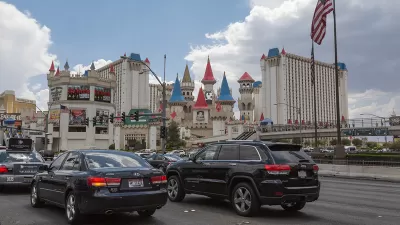Peak VMT reportedly occurred in 2007, but that may not stand long according to updated DOT estimates of 2013 travel. According to the data, Americans drove nearly three trillion miles. Another finding is the large increase in number of vehicles.
"According to Federal Highway Administration's (FHWA) 'Highway Statistics,' an annual compilation of data from state Departments of Transportation, drivers traveled 2.99 trillion miles in 2013, the highest annual total since 2007 and the fourth-highest since such record keeping began in 1936," states the press release.
[As of this writing, the entire FHWA website was inaccessible—hopefully it will be working when this post is published. The press release is accessible via Autoblog. The DOT-FHWA page was available.]
As noted in our January post on mileage data for the month of November 2014, "drivers logged 3.031 trillion miles [in 2007], the most in history. Our September post on estimates revealed "that American driving between July 2013 and June 2014 is at levels not seen since 2008."
The other finding on the number of motor vehicles operating on America's roads and highway in 2013 shows "the number increased to 255.9 million from 253.6 million the previous year, the biggest single-year increase since 2011."
The DOT Office of Public Affairs used the release to plug President Obama's $478 billion GROW AMERICA Act and to call for greater transportation investment.
FULL STORY: U.S. Driving at Highest Level Since 2007, New Data Show

Manufactured Crisis: Losing the Nation’s Largest Source of Unsubsidized Affordable Housing
Manufactured housing communities have long been an affordable housing option for millions of people living in the U.S., but that affordability is disappearing rapidly. How did we get here?

Americans May Be Stuck — But Why?
Americans are moving a lot less than they once did, and that is a problem. While Yoni Applebaum, in his highly-publicized article Stuck, gets the reasons badly wrong, it's still important to ask: why are we moving so much less than before?

Using Old Oil and Gas Wells for Green Energy Storage
Penn State researchers have found that repurposing abandoned oil and gas wells for geothermal-assisted compressed-air energy storage can boost efficiency, reduce environmental risks, and support clean energy and job transitions.

Updating LA’s Tree Rules Could Bring More Shade to Underserved Neighborhoods
A new USC study finds that relaxing Los Angeles’ outdated tree planting guidelines could significantly expand urban tree canopy and reduce shade disparities in lower-income neighborhoods, though infrastructure investments are also needed.

California's Canal Solar Projects Aim to Conserve Resources and Expand Clean Energy
California’s Project Nexus has begun generating electricity from solar panels installed over irrigation canals, with researchers and state agencies exploring statewide expansion to conserve water and boost clean energy production.

HHS Staff Cuts Gut Energy Assistance Program
The full staff of a federal program that distributes heating and cooling assistance for low-income families was laid off, jeopardizing the program’s operations.
Urban Design for Planners 1: Software Tools
This six-course series explores essential urban design concepts using open source software and equips planners with the tools they need to participate fully in the urban design process.
Planning for Universal Design
Learn the tools for implementing Universal Design in planning regulations.
Heyer Gruel & Associates PA
City of Moreno Valley
Institute for Housing and Urban Development Studies (IHS)
City of Grandview
Harvard GSD Executive Education
Salt Lake City
NYU Wagner Graduate School of Public Service
City of Cambridge, Maryland





























